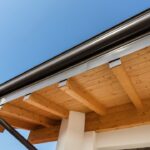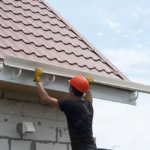When you look at your home, you often ponder, What kind of roof do I have? It’s here where the essence of architecture meets the safety of planning. Having knowledge about your roof type is a tremendous advantage. Whether you’re considering selling your home or planning some rooftop renovations, knowing your roof’s specific type can make all the difference.
Your roof, as a protective shield, is exposed to various elements. Understanding its intricacies not only equips you with the knowledge to maintain it properly but also helps with potential upgrades. In the upcoming sections, we’ll delve deep into the delightful world of roofs, understanding their types, materials, and much more.

1. Introduction
Your roof is more than just the topmost layer of your home. It protects, shelters, and adds aesthetic value. Let us begin this journey to understanding different roof types and why this knowledge is crucial.
2. The Big Picture: Types of Roofs
2.1 The Gable Roof
The gable roof, often seen in cottages, is triangular. Known for its simplistic design, it effectively sheds water and snow in regions with high precipitation.
2.2 The Hip Roof
A more complex design than gable, the hip roof slopes on all sides, making it highly stable. It is delightful for areas with high winds.
2.3 The Mansard Roof
Often found in French-inspired buildings, this sophisticated roof is designed with four double-sloped sides. It’s terrific for adding extra living space.
3. Exploring Roof Materials
When considering What kind of roof do I have?, the material is just as important as the shape. From asphalt to clay, each material offers something unique.
3.1 Asphalt Shingles
Economical and durable, these shingles are favored widely in the US. Their flexible nature makes them suitable for many roofing styles.
3.2 Metal Roofing
Offering longevity and a sleek appearance, metal roofs are modern marvels. They stand resilient against harsh weather conditions.
3.3 Clay Tiles
For a Mediterranean charm, clay tiles bring in aesthetics and durability. They’re highly resistant to fire and rot.
4. Advantages of Knowing Roof Types
Familiarizing yourself with your roof type offers a multitude of benefits. From better maintenance practices to informed decision-making, it dramatically influences your home’s longevity.
5. Assessing Your Roof
Before hiring professionals, here’s how you can inspect your roof and determine its type on your own.
6. Learning About Roofing Technology
With advancements in technology, roofing materials have significantly evolved. Understanding these changes can be a tremendous asset.
7. Common Distinctions Between Roof Types
As you explore different roof types, grasping their subtle differences can empower you to choose the right one for your needs.
8. Maintenance Tips for Your Roof
Every roof type requires specialized maintenance. Here are some general tips to ensure your roof remains in terrific condition throughout its lifespan.
9. Delighted Customers Speak
Your experience might resonate with others. Here are stories from homeowners to shed light on their encounters with various roof types.
10. When to Call in the Professionals
Recognizing the signs that your roof requires professional insight is key to preventing damage or addressing potential issues.
11. Roof Types Approved for Various Climates
Depending on where you live, some roof types might be more suitable than others. Here’s a quick guide.
12. Delving into Eco-friendly Roofs
Learn about roofing options that are environmentally sound and equally durable. It’s a big step towards sustainability.
13. Financial Aspects of Roofing
From budgeting for maintenance to considering potential replacements, understanding roofing costs is essential.
For detailed insight on expenses, check this external link.
14. Technology Advancements in Roofing
Innovations in roofing materials and techniques have transformed the industry remarkably over the years.

15. Conclusion
Your roof is a fundamental component of your home. Understanding what kind of roof you have is critical to maintaining its structure, function, and appearance over time. With the right information and preparation, you can ensure your roof lasts for decades to come.
FAQs
- How can I determine what kind of roof I have?
Begin by examining your roofs shape and materials. Observing distinctive features helps. You may also consult with professionals for a thorough assessment. - Why is it important to know my roof type?
Understanding your roof type informs maintenance practices, influences aesthetic choices, and can even affect your homes resale value. - What should I do if my roof requires repair?
It’s crucial to consult with a professional who can provide a reliable assessment and suggest suitable repair options.
This article contains affiliate links. We may earn a commission at no extra cost to you.







